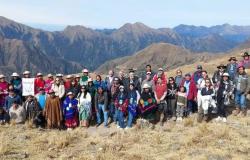Maritza Villegas / Special for La Jornada
Three hundred and thirty-eight millimeters of accumulated rain were generated at the Micos hydrometric station, from June 19 to 23, after the passage of the storm and the remnants of Albert in the Huasteca Potosina, which was the largest in the entire Valles River basin.
Precipitation exceeded the historical average for this month of June, of 227 mm; The volume was so extraordinary that it represents three quarters of the precipitation recorded in the entire year 2019, where 414 mm fell, at the Santa Rosa station.
The accumulated rainfall allowed the Valles River to increase its level and register a maximum of 3.95 meters, at the Micos station, a scale that has not been seen since August 2021, when the river reached 3.97 m. Currently, the flow continues to decrease and is at 2.41 meters.
The waterfalls are still active and in their maximum splendor.
Let us remember that the exceptional drought, present for more than four years, kept the tributary at critical minimum levels: in Micos, 20 cm, and Santa Rosa, 33 cm, which led to actions to suspend agricultural irrigation since April, in the Valles River basin, by Conagua, and to raise the banks in the area of the DAPA sump.
Édgar Lárraga, president of the Ciudad Valles Livestock Association, reported that the countryside benefited from these rainfalls that provide relief to the drought present in the area, but that it is not enough to completely fill the dams, the land dried it consumed it. He said that the rain was beneficial, and they are happy about this humidity.
“Some dams are already full, but we still have a long way to go, the drought is not over. We need the rainfall to continue, the humidity recorded will allow the field to begin preparing, there are already some producers who are beginning to throw the seed to start sowing grass, in two or three months we will see the benefits,” declared the rancher.
He pointed out that producers must be attentive because after a drought as widespread as the one experienced, it is likely that pests such as locusts and the inchworm will begin to emerge, so they must work twice as hard to eradicate them.
He recommended carrying out biological control to eliminate it and using pesticides as little as possible.






